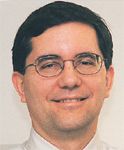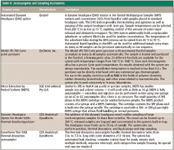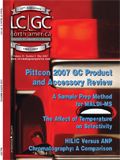New Gas Chromatograpy Products at Pittcon 2007
LCGC North America
The 58th Pittsburgh Conference on Analytical Chemistry and Applied Spectroscopy was held February 25 to March 1, 2007, at McCormick Place in Chicago, Illinois.
This year's conference attendance was up significantly from last year's meeting in Orlando, Florida, which is the same trend seen in previous years. Each time the conference has moved north, attendance has gone up compared to the year before. Still, the size of the exhibition was noticeably smaller. This did not detract from the quality of convention floor encounters. If anything, it made the whole affair more intense. Again, as in previous years, conference papers and posters were strong contributors to the technical content and remain a major attendee draw.

John V. Hinshaw
Gas Chromatography Product Introductions
This year, Pittcon saw a larger number of new gas chromatography (GC) instrument introductions than at any previous Pittcon that I can recall. These new GC systems share several common characteristics: they are faster, easier to maintain, and easier to use than their predecessors. This reflects the ongoing trend toward getting more out of each instrument to reduce cost of ownership while at the same time holding the line or even improving reliability and results quality. At the same time, most of the new instruments can include mass spectrometry (MS) detectors as standard line items that are almost plug-and-play devices. Many also have available multidimensional options that span a range of capabilities from simple column or detector maintenance options, through backflushing or heart-cutting operations, all the way to cutting-edge comprehensive GC×GC capabilities. Beyond new instruments, the rest of the new product field was dominated by sampling systems and accessories, followed by other items such as flow controllers or filters. Overall, the GC market is healthy and still growing. Although some of the new instruments were shown at other conferences earlier in the year, Pittcon remains the premier venue for GC products.
This annual installment of "GC Connections" reviews new GC instrumentation and accessories shown at this year's Pittcon; some of the entries were introduced earlier in 2006. For a review of new chromatography columns and accessories, please see "Column Watch" in the March and April 2007 issues of LCGC North America (1,2). The information presented here is based upon manufacturers' replies to questionnaires received up until a few weeks before the conference, as well as on additional information from manufacturers' press releases, websites, and product literature. During the conference, I took time to walk around the convention aisles and see some of the new products firsthand as well as discover a number of items that were not covered by the questionnaires. Every effort has been made to collect accurate information, but due to the preliminary nature of some of the material, LCGC cannot be responsible for errors or omissions. This article cannot be considered to be a complete record of all new GC products shown at this year's Pittcon, because not all manufacturers chose to respond to the questionnaire, nor is all of the submitted information included here due to the limited available space and the editor's judgment as to the suitability.

Table I: New GC instruments
Instrument Systems
The number of new instruments this year is remarkable, considering the mature state of GC. As the list in Table I shows, GC is alive and going strong. The various companies introduced laboratory-sized, miniaturized, and micro instruments. Faster sample throughput, improved reliability, and ease-of-use are common themes among the laboratory instruments, while the smaller miniaturized models feature application-specific capabilities.
PerkinElmer (Shelton, Connecticut) first showed the new Clarus 600 GC and MS systems in the fall of 2006. Like many new instruments, the Clarus 600 is a major update to an existing system, which in this case adds a unique cylindrical oven with fast heat-up and cool-down speeds, new electronics, several MS pump options, and updated reporting software. The Clarus 600 optionally features PreVent column switching to aid inlet liner changes and has a full range of inlets, detectors, and sampling options. From Agilent (Wilmington, Delaware), the model 7890A GC and 5975C Mass Selective Detector (MSD) continues the company's progression of advances in GC and GC–MS instrumentation. The model 7890A features increased oven cool-down speeds, capillary flow technology that enables faster analyses through column switching, a new "turn-top" split–splitless inlet, and a new suite of diagnostic software and monitoring tools. The model 5975C MSD has a new design gold quartz quadrupole with extended heating range, a lower detection limit, and synchronous single-ion monitoring (SIM)–scan ion monitoring.

Table II: Autosamplers and Sampling Accessories
Thermo (Waltham, Massachusetts) introduced the DSQ II Series Dual Stage Quadrupole GC–MS system with updated ionization source and electron multiplier detector with dynode conversion. Varian (Walnut Creek, California) showed the model 320-MS triple quadrupole, which can switch between liquid chromatography (LC) and GC modes as required. The QP-2010 Plus from Shimadzu (Columbia, Maryland) is an upgraded version of the QP-2010S, shown at last year's conference, with extended mass and source temperature ranges, larger available turbomolecular pump, and simultaneous scan/SIM modes.
DANI (Cologno Monzese MI, Italy) showed the Master GC fast gas chromatograph, a completely new model designed for high performance fast laboratory applications. The Master GC features a touch-screen display with realtime chromatogram injection counter for maintenance purposes. Rounding out the product line are a matched liquid autosampler with a 160-sample tray and 0.1–500 μL sample sizes, and a thermal desorber. Another laboratory instrument, the DPS-600 Series GC system from DPS Instruments, Inc. (Ontario, California), features modular flexibility with three basic instrument frames onto which can be added up to four inlet and five detector options, along with valving and automated samplers from a full range of available options. Single- and dual-oven combinations are possible. The Konik MSQ12 Series C GC–MS system combines a high-performance quadrupole MS detector with the company's GC and LC–GC systems.

Table III: General accessories
In the small-GC arena, PID Analyzers (Pembroke, Massachusetts) showed its model GC312 portable GC system, a lightweight battery-powered unit. Torion Technologies (Pleasant Grove, Utah) introduced the GuardIon-7 hand-portable GC-torodial ion-trap mass spectrometer (TMS) as well as a laboratory version of the same technologies. C2V (Enschede, The Netherlands) continues to offer evaluation modules with its micro electrical-mechanical systems (MEMS) devices in a gas chromatography configuration and have expanded some of the features of its systems.
Autosamplers and Sampling Accessories
This year's autosampling introductions continued to focus on the preparation and conditioning of difficult sample matrices for successful GC analysis. Gerstel (Baltimore, Maryland), for example, showed a new automated dynamic headspace option for its automated Multipurpose Sampler product line that thermostats and agitates samples under tightly controlled conditions so that the extracted and recovered headspace gases are highly reproducible. DyChrom (Santa Clara, California) introduced a new Curie-point pyrolyzer that uses the chemical characteristics of specific alloys to raise samples rapidly to specific repeatable temperatures. CDS Analytical (Oxford, Pennsylvania) introduced a dynamic headspace option for its model 5200s thermal desorber–pyrolyzer, which extracts headspace gases from as much as 25 mL of sample. The company also showed the Dynatherm TDA 9300 thermal desorption autosampler, which handles large sample tubes, performs automated leak checking, and requires no cryogen for subambient trapping of evolved gases.

Companies Listed in This Column
Meanwhile, SGE (Austin, Texas) introduced a new twist on active adsorption–desorption sample preparation with micro-extraction by packed sorbent (MEPS). Similar in principle to solid-phase microextraction (SPME), MEPS uses a packed solid-phase extraction (SPE) sorbent in a syringe-encased cartridge that passes sample, extraction solvent, or cleanup solvent over the sorbent material. Extraction and desorption can be carried out online automatically with a liquid autosampler.
General Accessories
A few general GC accessories stood out at this year's Pittcon. The H2 PEM series of hydrogen generators from Parker Hannifin (Tewksbury, Massachusetts) are available in a variety of capacities. Models produce hydrogen via a proton-exchange membrane that requires only deionized water for operation. Models that include a palladium purifier model to remove oxygen and water produce carrier-gas grade hydrogen.
From Restek (Bellefonte, Pennsylvania), the Alumaseal capillary GC column connector is a unique front and back ferrule design that is mechanically stable and tolerates temperatures as high as 550 °C. The device can be used very well in GC–MS applications and does not require retightening after temperature cycling.
Finally, the new Micro-Trak electronic flow controller from Sierra Instruments (Monterey, California) controls gas flows less than 4 sccm with high accuracy and repeatability. This device would find application for capillary GC column flow control with direct or on-column injection as well as in certain column-switching applications.
Conclusion
Pittcon remains the premier venue for instrument companies to introduce their newest wares to the analytical chemical community. Although GC is well over 50 years old, it continues to see significant new instrument systems and accessories introduced every year, along with significant interest in new, rising technologies such as GC×GC. It is unlikely that this year's spike in new instrument rollouts will continue into 2008 when Pittcon returns to New Orleans. I am looking forward, though, to seeing what new developments will transpire as the energy infused into the GC world this year stimulates related and derived product developments moving forward.
John V. Hinshaw
"GC Connections" editor John V. Hinshaw is senior staff engineer at Serveron Corp., Hillsboro, Oregon, and a member of LCGC's editorial advisory board. Direct correspondence about this column to "GC Connections," LCGC, Woodbridge Corporate Plaza, 485 Route 1 South, Building F, First Floor, Iselin, NJ 08830, e-mail lcgcedit@lcgcmag.com
For an ongoing discussion of GC issues with John Hinshaw and other chromatographers, visit the Chromatography Forum discussion group at http://www.chromforum.com.
References
(1) R.E. Majors, LCGC 25(3), 248–266 (2007).
(2) R.E. Majors, LCGC 25(4), 340–358 (2007).

New Study Reviews Chromatography Methods for Flavonoid Analysis
April 21st 2025Flavonoids are widely used metabolites that carry out various functions in different industries, such as food and cosmetics. Detecting, separating, and quantifying them in fruit species can be a complicated process.
University of Rouen-Normandy Scientists Explore Eco-Friendly Sampling Approach for GC-HRMS
April 17th 2025Root exudates—substances secreted by living plant roots—are challenging to sample, as they are typically extracted using artificial devices and can vary widely in both quantity and composition across plant species.
Sorbonne Researchers Develop Miniaturized GC Detector for VOC Analysis
April 16th 2025A team of scientists from the Paris university developed and optimized MAVERIC, a miniaturized and autonomous gas chromatography (GC) system coupled to a nano-gravimetric detector (NGD) based on a NEMS (nano-electromechanical-system) resonator.

.png&w=3840&q=75)

.png&w=3840&q=75)



.png&w=3840&q=75)



.png&w=3840&q=75)












